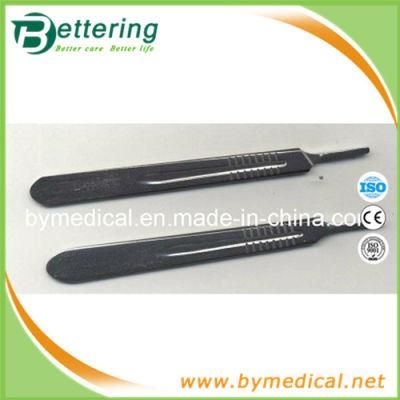- Model NO.:NO 3 & NO 4
- Logo Printing:Without Logo Printing
- Handle Material:Stainless Steel
- Size:#3, #4
- Delivery Time:25 Working Days for Regular Order
- OEM Brand:Available
- Sterilization:Eo Sterile
- Transport Package:1PC,Bag, 10PCS,Box, 50boxes,CTN
- Specification:CE,ISO approved
- Trademark:Bettering
- Origin:Jiangsu, China
- HS Code:90189090
- Production Capacity:1000000PCS Per Month
| Product Name | Surgical Blade |
| Kinds of Blade | Carbon Steel Blades, Stainless Steel Blades and Stitch Cutting Blades |
| Size | No.10, 11, 12, 12B,12D, 13, 14, 15, 15C, 16, 18, 19, 20, 21, 22, 23,
24, 25, 36 |
| Sterilized | By Gamma |
| Certificates | ISO,CE |
| Packing | 100 pcs/box, 50 box/ctn , 36x20x17cm,9kgs |
| MOQ | 10000 pcs |
| Delivery Time | 5-25 days after the deposit |
| Port of loading | Shanghai |
Application
| Size | Application |
| No.10 | with its curved cutting edge is one of the more traditional blade shapes and is used generally for making small incisions in skin and muscles . The No.10 is often utilised in more specialised surgeries such as harvesting the artery during a coronary artery bypass operation, opening the bronchus during thoracic surgery and for Inguinal hernia repair. |
| No.11 | is an elongated triangular blade sharpened along the hypotenuse edge and with a strong pointed tip making it ideal for stab incisions. Used in various procedures such as the creation of incisions for chest drains, opening coronary arteries, opening the aorta and removing calcifications in the aortic or mitral valves |
| No.12 | is a small, pointed, crescent shaped blade sharpened along the inside edge of the curve. It is sometimes utilised as a suture cutter but also for arteriotomies ( surgical incision of an artery), parotid surgeries (facial salivary glands), mucosal cuts on a septoplasty (repair of nasal septum) and during cleft palate procedures, ureterolithotomies (calculus removal by incision of the ureter) and pyelolithotomies (surgical incision of the renal pelvis of a kidney for the removal of a kidney stone - also known as a pelviolithotomy ). |
| No.12D | (sometimes referred to as the 12B in the USA), is a double edged No. 12 blade sharpened along both sides of the crescent shaped curve. It is used extensively within dental surgery techniques. |
| No.14 | mostly used in aesthetic procedures that help to rejuvenate the skin's top layers through a method of controlled surgical scraping. |
| No.15 | has a small curved cutting edge and is the most popular blade shape ideal for making short and precise incisions. It is utilised in a variety of surgical procedures including the excision of a skin lesion or recurrent sebaceous cyst and for opening coronary arteries. |
| No.15C | with a longer cutting edge than the traditional No.15 blade. Mostly used by dentists carrying out periodontal procedures |
| No.20 | is a large version of the No.10 blade with a curved cutting edge and an unsharpened back edge. Used for orthopaedic and general surgical procedures |
| No.21 | is a large version of the No.10 blade with a curved cutting edge and an unsharpened back edge. Larger than the No.20 but smaller than the No.22. |
| No.22 | is a large version of the No.10 blade with a curved cutting edge and an unsharpened back edge. Used for skin incisions in both cardiac and thoracic surgrey and to cut the bronchus in lung resection surgery. Larger than the No.20 and No.21. |
| No.23 | has a flat, unsharpened back edge and a curved cutting edge. Used mostly for making long incisions such as an upper midline incision of the abdomen during the repair of a perforated gastric ulcer. |
| No.24 | is slightly larger than the No.23 blade and is more semi circular in shape. Used for making long incisions in general surgery and also in autopsy procedures. |
| No.36 | is a large blade mostly used in general surgery but also in histology procedures.
|

